Trek didn’t just launch a new bike when it debuted the Domane endurance platform in 2012; it introduced a groundbreaking way to increase rider comfort with its innovative IsoSpeed ‘decoupler’ — a mechanical pivot at the seat cluster that allows the entire seatmast and seatpost to flex much more under load than a more traditionally built frame. IsoSpeed is once again what defines the Domane but a second-generation, adjustable version has now been incorporated into the brand-new Domane SLR family along with a front version to match, creating what is quite possibly the smoothest-riding road bike on the market.
DUAL ISOSPEED IS TWICE AS NICE WITH NO ADDED WEIGHT
The original IsoSpeed concept relied on the entire seat tube to flex under bump forces but this latest Domane SLR borrows the current Madone’s twin seat tube design to separate structural and ride comfort roles. The new Domane SLR still incorporates a ‘decoupler’ at the seat cluster but whereas the original Domane’s seat tube and integrated seatmast were one continuous section, those parts are split apart on the Domane SLR and sandwiched next to each other with the smaller half behaving like a flattened leaf spring. The main seat tube is now rigidly attached to the top tube and down tube as on a conventional carbon fibre frame while the thinner, secondary seat tube is moulded as one piece with the no-cut integrated seatmast and anchored down near the bottom bracket. It’s this smaller, secondary frame section that passes through the IsoSpeed decoupler.
Quite ingeniously, you can now even tune the stiffness of that spring by sliding the spacer that separates the two seat tubes up and down. Moving it toward the bottom bracket yields the longest spring and softest spring rate; moving it up makes it progressively shorter and stiffer. According to Trek, the most comfortable setting is now 14% softer than before but the least is 25% more firm. Changing the ride quality requires just a few seconds with a 4mm hex wrench and your fingers.
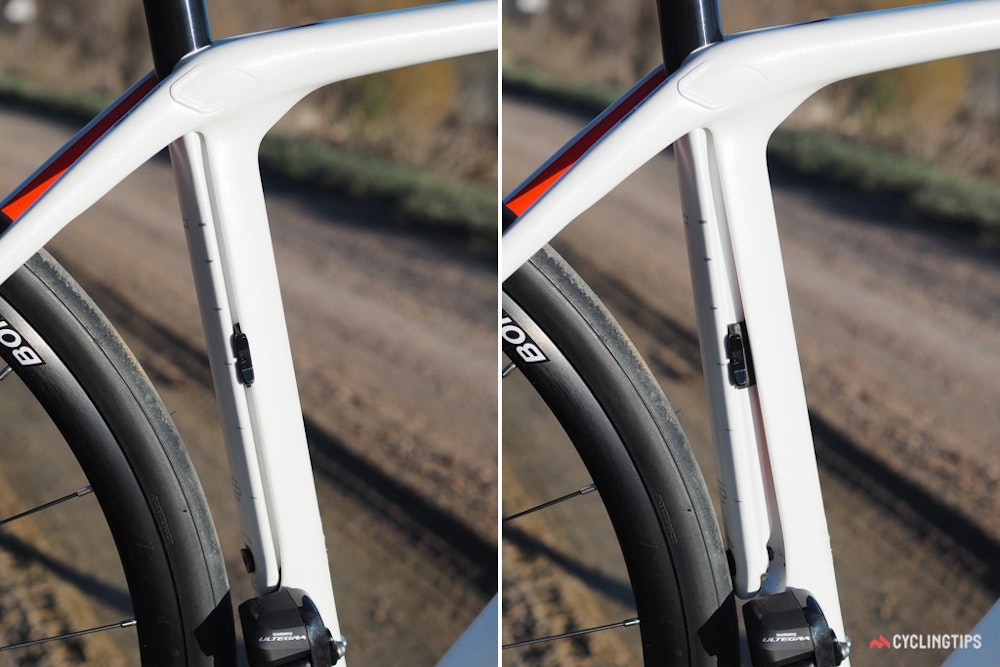
The nested seat tubes almost seem like a single piece of carbon fibre from afar but when you remove the anchor bolt at the bottom, you can see that they’ve very much separate pieces.
While the original Domane was an impressive achievement, one of the most pointed criticisms was its somewhat disjointed ride quality: the rear end was super cushy but the front end was comparatively harsh. Rather remarkably, Trek has managed to replicate the IsoSpeed mechanism up front with a pivoting subassembly housed inside the top of the head tube that lets the steerer tube bend more on bumpy terrain. The result is a much more balanced ride on the Domane SLR.
“[The development of Front IsoSpeed] started very early on, even before we launched the last bike,” Trek road product manager Ben Coates told CyclingTips. “We consistently felt and heard that the rear end was so good that it made the front end feel noticeably different. But in that compliment was an opportunity that we couldn’t get out of our minds. As we were racking our brains how to balance out the ride, some product manager just kept saying, ‘I don’t understand why you can’t just take that from the back and put it in the front.’ After a few months, a couple of our engineers got together and had an a-ha moment.”
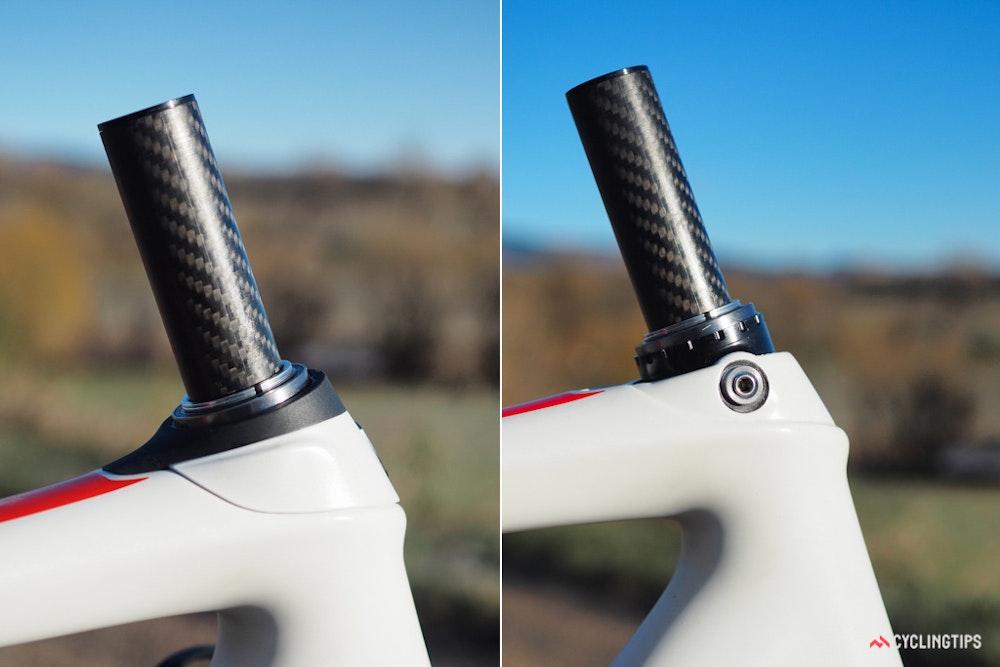
Underneath the Front IsoSpeed’s cosmetic cover and rubber seal is the same type of pivoting ‘decoupler’ that Trek uses out back.
Although the Front IsoSpeed concept sounds radical, keep in mind this isn’t the first time Trek has dabbled with tuned-in steerer tube flex. Previous-generation Madones and Domanes already use steerer tubes that are flattened on their front and rear sides to help them bend a bit under load but Trek says the new Front IsoSpeed mechanism adds another 5-10% more vertical movement at the bars (depending on stem length and rider hand position) than the current Domane. The thought of a steerer tube repeatedly bending over time may give some riders pause — let alone a system that actually encourages the movement. But if you think about it, the Front IsoSpeed mechanism may let the steerer bend more than before but it’s a larger-radius bend with less concentrated stress. In other words, the addition of IsoSpeed should actually improve the fatigue life of the fork, not shorten it.
“All of our forks, including the new Domane fork, go through the same extensive testing — testing that goes above and beyond industry and governmental standards,” Coates said. “Your suspicions are correct, though. Because we are able to reduce point load at the upper headset bearing, we do actually have a better structural design for the bearing/steerer tube interface. This allows us to reduce weight.”
Speaking of weight, all of that additional aluminium and steel hardware is obviously heavier than an equivalent all-carbon head tube but Trek claims that design efficiencies in other locations on the Domane SLR more than cancels that out. In fact, claimed frame weight is an impressive 950g for an unpainted 56cm sample – 100g lighter than the original Domane – plus 330g for the matching fork. Coates says paint will add 5-200g depending on the finish, and both the disc and rim brake versions are virtually identical on the scale.
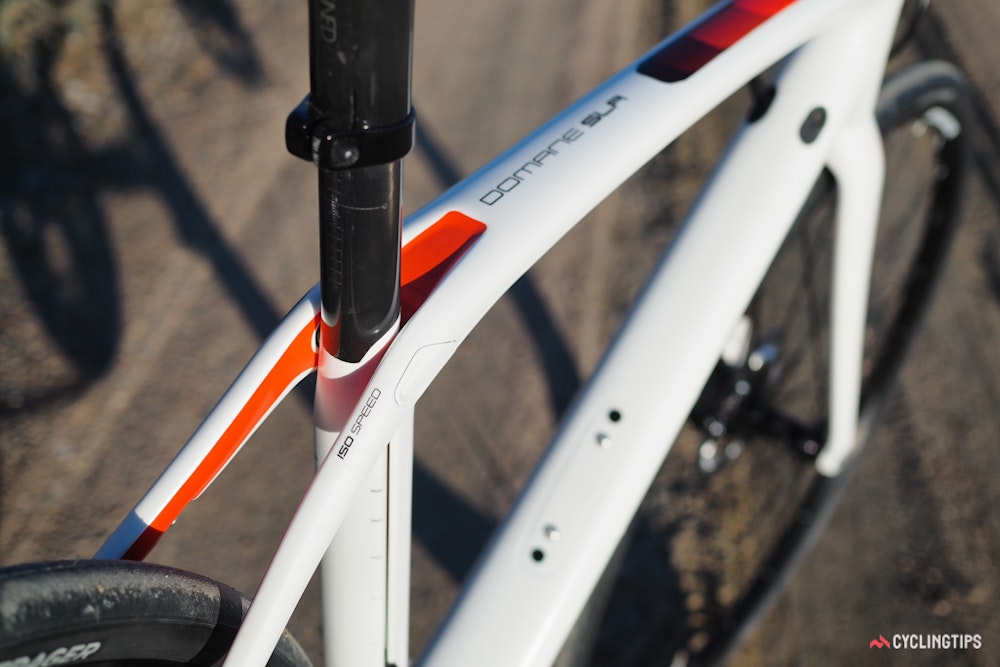
The innovative IsoSpeed ‘decoupler’ is what truly sets the Domane family apart. It seemed gimmicky when it was first introduced in 2012 but it works remarkably well.
Further balancing out the ride is the new IsoCore handlebar, which utilises a layer of rubber inside the carbon fibre lay-up. Trek claims the additional rubber layer produces 20% more movement at the hoods under load than a conventional all-carbon bar — or 24% more than an aluminium one — while still weighing posting a reasonable weight of 236-267g, depending on size.
Tire clearance gets a big boost, too. Whereas the previous Domane was only approved for 25mm-wide tyres across the board, rim brake-equipped Domane SLR models will now officially swallow 28mm ones while the Domane SLR Disc gains another 4mm of room on top of that. Bear in mind that those limits are based on government-mandated regulatory clearances and riders who are willing to take a bit more risk (and don’t plan on trudging through the mud) will likely find space for even higher-volume rubber. For example, some cyclocross knobbies will physically pass through the fork blades and stays but without any wiggle room for debris or a wheel that falls out of true so it’s not something I recommend trying.
Other new features on the Domane SLR include a removable ‘Control Center’ access panel in the down tube to house the battery on Shimano Di2-equipped models, flat-mount calliper interfaces on disc brake-equipped versions, and direct-mount callipers on bikes with rim brakes. Disc-equipped bikes also move to 12mm-diameter thru-axles front and rear while bikes with rim brakes stick with quick-release open dropouts.
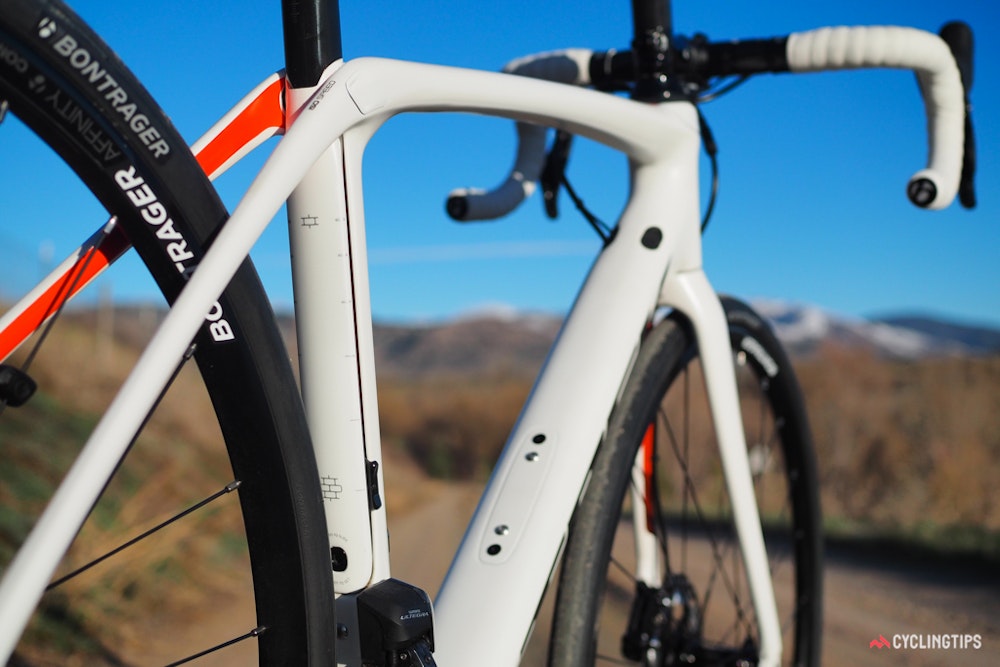
The pictorial guide on the back of the seat tube is pleasantly simple to understand. More cobbles equals a softer ride; fewer equals a firmer one.
Key traits from the original Domane carry over unchanged, including the relatively upright rider positioning, ultra-stable handling, hidden fender mounts, integrated chain catcher, 1 1/8-to-1 1/2in tapered steerer tube, and BB90 bottom bracket shell with direct press-fit bearings.
Trek will offer the new Domane SLR in five complete bikes to start — two with disc brakes and three with rim brakes — plus one rim and one disc frameset, all with the standard Endurance geometry and a generous size range from 44-62cm. There will also be a team-replica Domane SLR Race Shop Limited edition with a more aggressive ‘Pro Endurance’ geometry that features a longer reach, shorter stack, and quicker handling, plus a more upscale 700-Series OCLV carbon fibre will also be available. Those will only be offered in 54-62cm sizes, however, since the Trek Segafredo team doesn’t have anyone of smaller statures on its classics squad. Both geometries will be offered through Trek’s Project One custom program (albeit only with rim brakes to start).
Prices and key component specs are as follows:
Domane SLR 9 eTap (US$11,000 / AU$15,000 / £7,600)
OCLV 600-Series frame and fork
SRAM Red eTap groupset
Bontrager Aeolus 3 D3 TLR wheelset
Domane SLR 7 Disc (US$6,500 / AU$n/a / £4,800)
OCLV 600-Series frame and fork
Shimano Ultegra Di2 drivetrain
Shimano R785 levers and brakes
Bontrager Affinity Comp wheelset
Domane SLR 7 (US$6,000 / AU$6,800 / £4,400)
OCLV 600-Series frame and fork
Shimano Ultegra Di2 groupset
Bontrager direct-mount brakes
Bontrager Paradigm Comp wheelset
Domane SLR 6 Disc (US$5,500 / AU$6,300 / £4,000)
OCLV 600-Series frame and fork
Shimano Ultegra 6800 drivetrain
Shimano R685 levers and brakes
Bontrager Affinity Comp wheelset
Domane SLR 6 (US$5,000 / AU$5,800 / £3,600)
OCLV 600-Series frame and fork
Shimano Ultegra 6800 groupset
Bontrager direct-mount brakes
Bontrager Paradigm Comp wheelset
Domane SLR Race Shop Limited frameset (US$TBC / AU$TBC / £TBC)
- OCLV 700-Series frame and fork
Domane SLR frameset (US$3,000 / AU$n/a / £2,400)
- OCLV 600-Series frame and fork
Domane SLR Disc frameset (US$3,000 / AU$n/a / £2,550)
- OCLV 600-Series frame and fork
FIRST IMPRESSIONS: RIDING THE NEW DOMANE SLR 7 DISC
Trek may have only officially launched its new bike in Belgium today but I received an early-production Domane SLR 7 Disc — the top-end disc-equipped version — several days prior to test on home soil. I mean that in the literal sense, too, seeing as how my sample has thus far spent plenty of time on pavement but even more time on the endless expanse of unpaved roads surrounding my Boulder, Colorado home base in order to better gauge the bike’s ride quality.
To simply say that the new Domane SLR is ‘smooth’ would be to do a gross disservice both to what Trek has achieved here and to anyone searching for the holy grail of comfort. Whereas many endurance bikes aim to reduce vibration, the Domane SLR’s ace in the hole is bona fide movement at the contact points — and a lot of it. In fact, it’s the closest thing to a full-suspension road bike currently available. It’s not just smooth; in the most comfortable setting, the frame is freakishly, otherworldly, and almost alarmingly calm and composed in how it utterly levels the ground beneath you. If you think this assessment borders on sycophantic, then so be it; but do yourself the courtesy of riding one first.
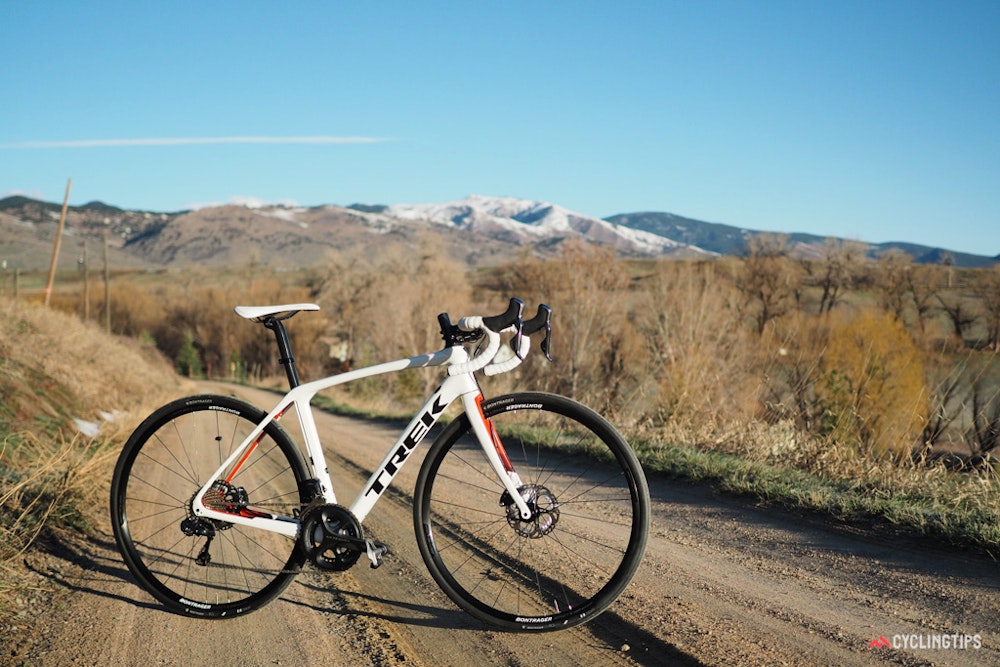
The new Trek Domane SLR is more comfortable than the original out back but more importantly, it now has a much more balanced feel up front, too.
Even better, the ride quality is far more balanced than the previous Domane could ever hope to be. Granted, the combination of the radical Front IsoSpeed and the surprisingly effective IsoCore handlebar still doesn’t equal the softness of the rear end but it’s a much better match than it used to be. Pavement cracks are seen but never felt and front-end impacts are met with little more than a dull thud through your hands; coarse road texture feels like polished granite. Since the Front IsoSpeed’s pivot axis is mechanically limited, there’s no out-of-plane vagueness when arcing through corners or when torquing the bars during climbs and sprints, either.
As before, there’s negligible bounciness from the pseudo-suspended rear end in most situations but it is possible to generate an odd oscillation at times – especially if you have a particularly ‘square’ pedal stroke or your position requires a lot of saddle setback. That said, I didn’t have any issues with it (nor did I with the previous version, either).
The adjustability of the rear IsoSpeed is tangibly effective. In its softest position, the Domane SLR decimates washboarded dirt country paths and poorly maintained pavement; in the firmest, it feels much like any other high-end carbon endurance frame. That said, anyone buying a Domane is almost certainly going to be drawn to the bike’s comfort so my suspicion is that most will gravitate toward the cushier end of the spectrum. For reference, Fabian Cancellara opted for the second-softest setting when he rode the new Domane SLR to victory at last month’s Strade Bianche and at this year’s Tour of Flanders.
Even better, the Domane SLR’s superb comfort doesn’t come at the expense of traditional performance metrics on smoother surfaces, either. As already mentioned, the frame is competitively light but since the bike’s ride quality is baked in with mechanical solutions, there’s no need to engineer much flex into the tubes themselves. As a result, the main frame and chainstays use enormous cross-section throughout and the chassis is amply stiff and efficient when sprinting or climbing out of the saddle.
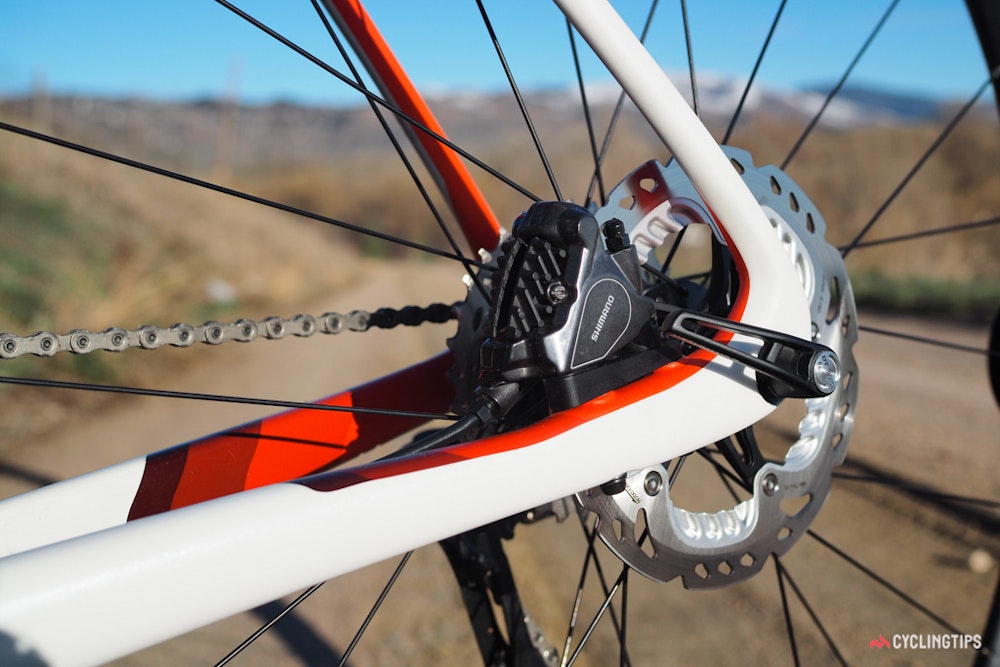
Disc-equipped Domane SLR frames feature flat-mount callipers at both ends, plus 12mm thru-axles front and rear.
That Trek has managed to build a phenomenally comfortable road bike isn’t in question but whether you actually like the feel may be. Whereas even the most heavily damped composite road frames still tend to transmit a fair bit of information on what’s happening at the tyre contact patches, the Domane SLR delivers a highly muted sensation throughout. I’ve little doubt that I was able to ride faster on rough sections of road than I would on a more unyielding frameset but the ride can be so thoroughly isolating at times that you could be forgiven for thinking there was something missing in the experience.
Geometry-wise, Trek has carried over intact the original Domane’s figures for this more upscale Domane SLR version and that may be a love-it-or-hate-it proposition as well. As compared to Trek’s more agile Madone and Emonda platforms, the Domane geometry is markedly longer, lower, and slacker with a bottom bracket that’s 10mm closer to the ground, a rear wheel more than a centimetre further behind you than typical race bikes, and a wheelbase that’s a whopping 3-4cm rangier from axle to axle. The front end is also 1-2 degrees slacker and rises up 4-5cm taller for a substantially more relaxed riding posture.
As a result, the Domane is ultra-stable but also slow to initiate turns, requiring a concerted lean to get the front end aimed at tight apexes. The unusual geometry also yields a feeling of sitting ‘in’ the bike rather than ‘on’ it — something not everyone will agree with. In fairness, the Domane isn’t about winning criteriums; it’s about gobbling up long stretches of road in comfort and the fact that it’s Trek’s best-selling road platform speaks volumes about how well that attitude appeals to the masses.
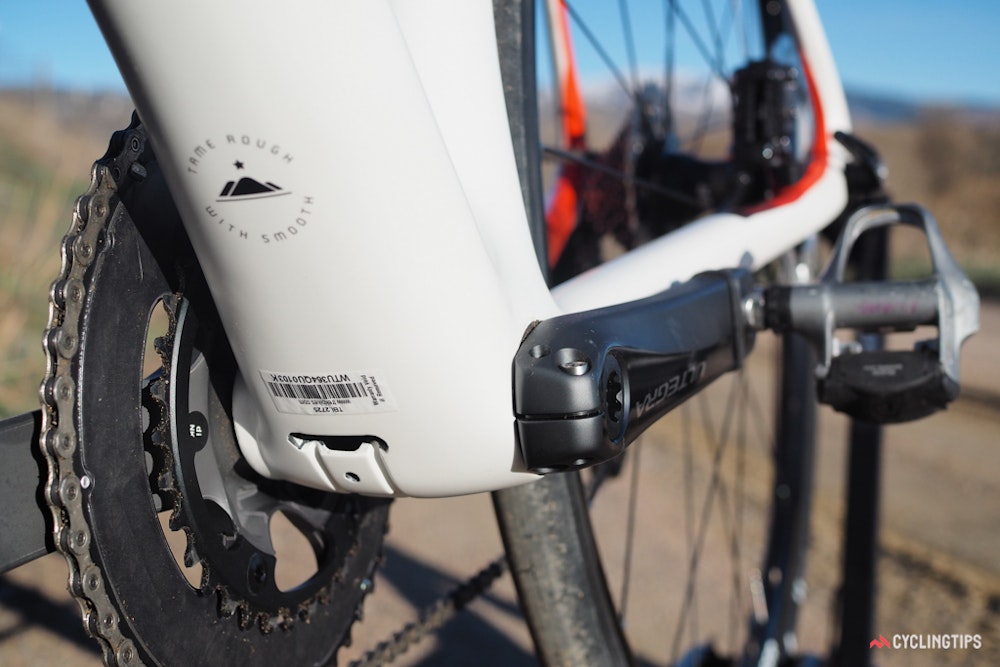
As has become standard on Trek high-end road frames, the bottom bracket bearings press directly into the carbon fibre shell with no additional cups required. The down tube and seat tube make full use of that extra real estate, too, measuring 90mm across at their widest points.
As for the component particulars of this Domane SLR 7 Disc edition, there’s not much to complain about. The stock 32mm-wide Bontrager tyres only further accentuate the smooth-riding chassis, and the wide-range 50/34T chainrings and 11-32T cassette on the Shimano Ultegra Di2 drivetrain play well with the bike’s versatility. Shimano sadly hasn’t squelched the incessant rattling and clunking in its hydraulic Dual Control levers, though, and while the Bontrager Affinity Comp aluminium clincher wheels are tubeless-compatible, the stock tyres are not.
Actual weight for my 52cm sample is 8.31kg (18.32lb) without pedals — quite a reasonable figure given the front and rear pseudo-suspension, disc brakes, and fat tyres.
Overall, it’s so far, so good but I’ll have a more in-depth review later after I’m able to log some more significant mileage.
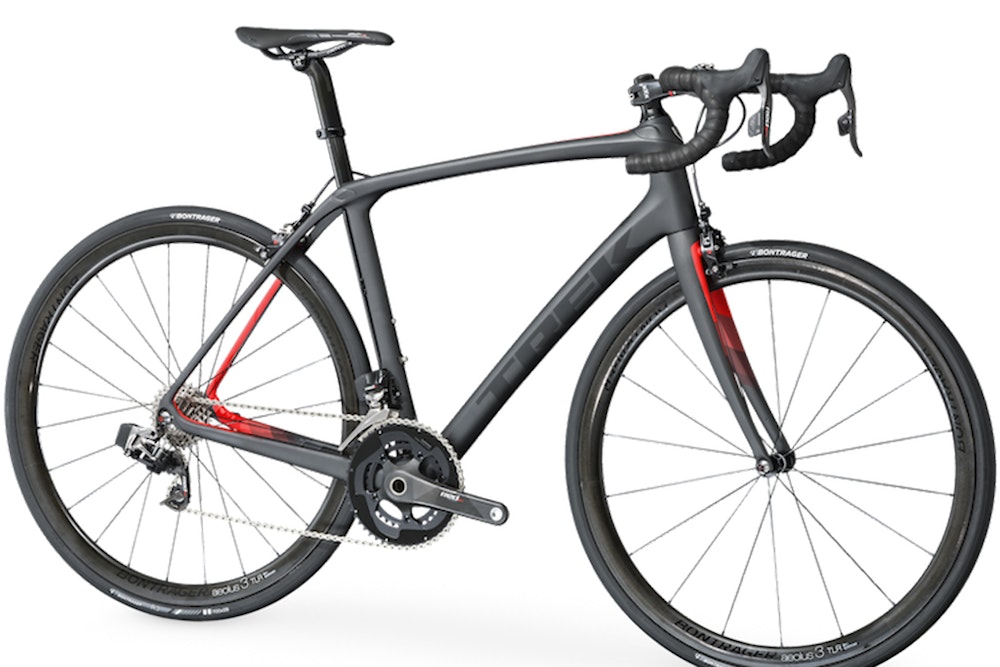
The Trek Domane SLR 9 eTap.
This article was originally published on cyclingtips.com





